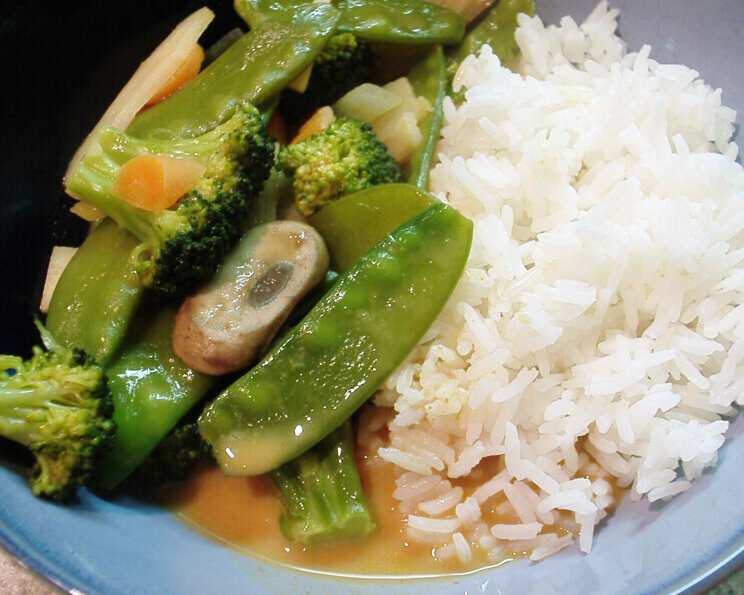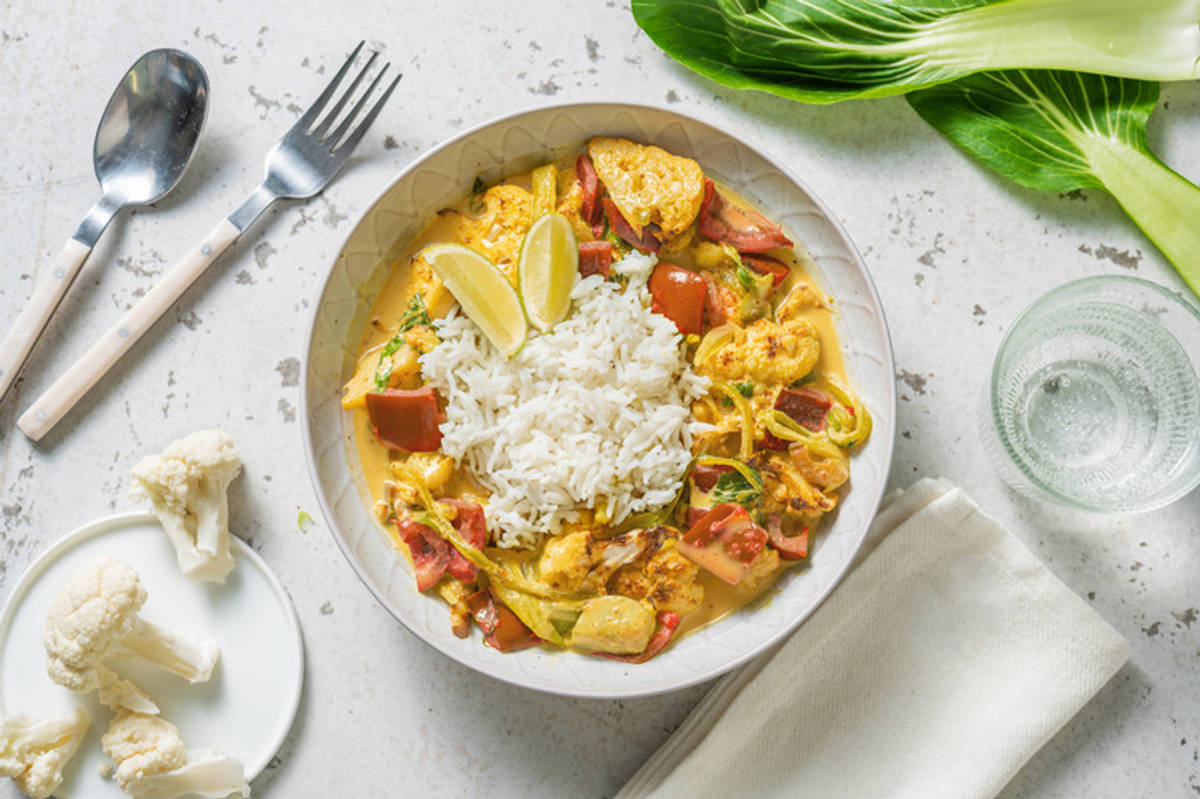Introduction to Thai Veg Red Curry
Thai red curry, a vibrant and flavorful dish, holds a significant place in Thai cuisine and beyond. Its rich history and unique characteristics make it a beloved culinary staple, both in Thailand and internationally. While pinpointing its exact origins is difficult, its development is intrinsically linked to the availability of ingredients and the evolution of Thai cooking techniques over centuries. The use of red chilies, a key ingredient, became more prevalent in Thai cooking during the Ayutthaya period (1351-1767), leading to the development of curries with bolder, spicier flavors.
The key characteristics distinguishing Thai red curry are its vibrant red color derived from red chilies, its rich and complex flavor profile built upon a balance of sweet, sour, salty, and spicy notes, and its characteristically creamy texture often achieved through the addition of coconut milk. Unlike other curries like Indian curries which often feature a broader range of spices and techniques, Thai red curry maintains a relatively focused flavor profile centered around the chili paste, lemongrass, galangal, and kaffir lime leaves. This focused approach results in a distinct and easily recognizable taste.
The Cultural Significance of Thai Red Curry
Thai red curry isn’t just a dish; it’s a reflection of Thai culture and culinary traditions. The balance of flavors within the curry mirrors the balance sought in Thai life – a harmony between contrasting elements. The preparation itself is often a communal activity, reflecting the importance of family and shared meals in Thai society. Different regions of Thailand may have variations in their red curry recipes, showcasing the diversity within the country’s culinary landscape. The dish’s presence in everyday life, from street food stalls to upscale restaurants, highlights its enduring popularity and cultural relevance. It’s a dish frequently served during celebrations and special occasions, further emphasizing its social and cultural importance. The meticulous preparation and careful balancing of ingredients demonstrates the respect and artistry involved in Thai cooking.
Essential Ingredients
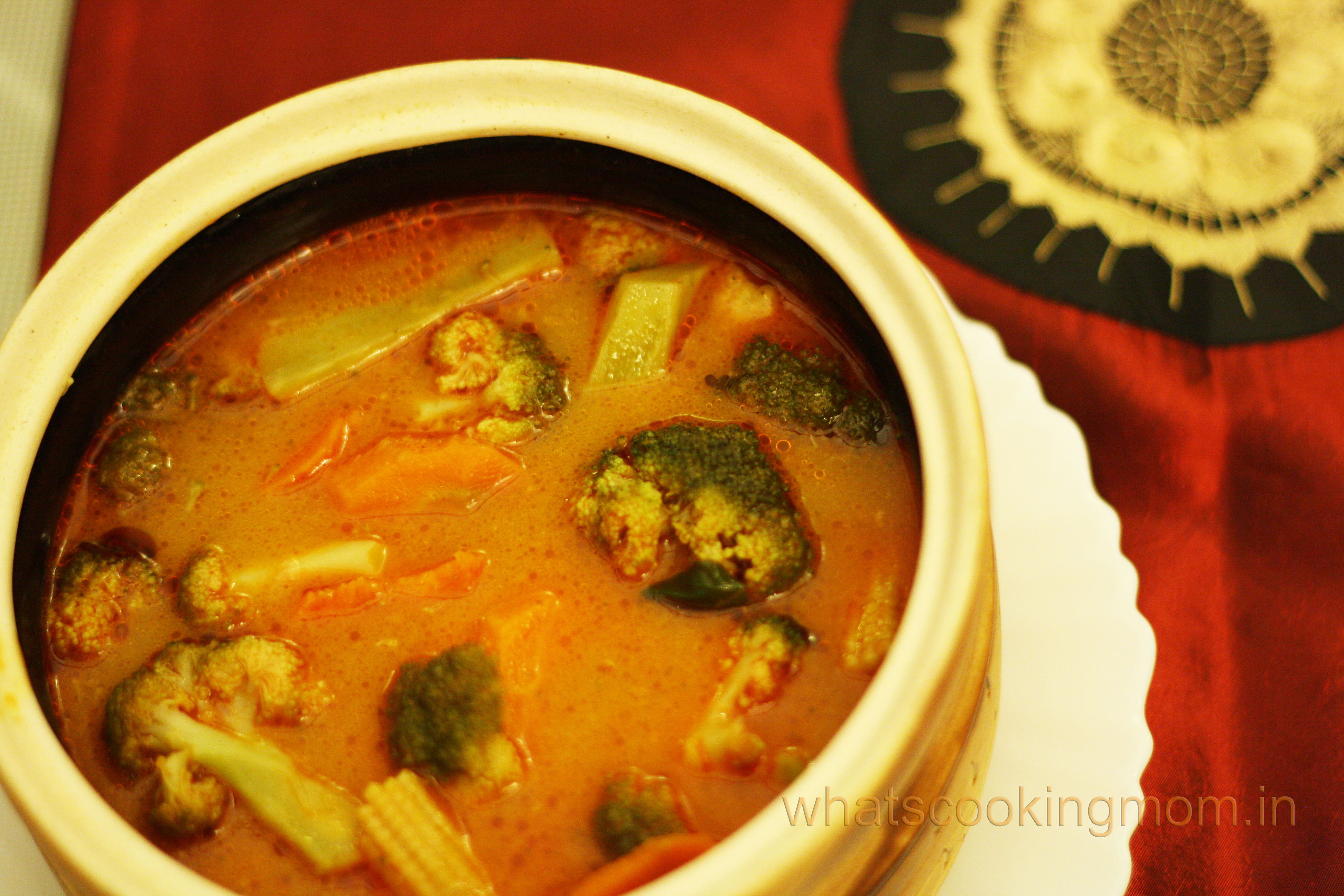
A delicious Thai veg red curry hinges on the careful selection and combination of its ingredients. The vibrant flavors and creamy texture are the result of a perfect balance between aromatic spices, fresh vegetables, and rich coconut milk. Let’s delve into the key components that make this dish so irresistible.
Thai veg red curry recipe – The foundation of any Thai red curry is, of course, the vegetables. The choice is incredibly versatile, allowing for seasonal variations and personal preferences. However, certain vegetables are commonly featured for their ability to hold their texture while absorbing the flavorful curry sauce.
Common Vegetables in Thai Veg Red Curry
The beauty of a Thai vegetable red curry lies in its adaptability. While recipes vary, a selection from the following vegetables usually forms the core of the dish. The quantities depend on personal preference and availability.
- Bamboo shoots: Provide a pleasant crunch and subtle sweetness.
- Bell peppers (various colors): Offer a vibrant color contrast and mild sweetness.
- Eggplant: Adds a soft, slightly smoky texture and flavor.
- Green beans: Contribute a crispness and fresh, vegetal taste.
- Broccoli florets: Offer a slightly bitter counterpoint to the richness of the curry.
- Carrots: Provide a touch of sweetness and a pleasant crunch.
- Snow peas or sugar snap peas: Add a delicate sweetness and vibrant green color.
- Mushrooms: Offer an earthy flavor and satisfying texture.
- Onions: Provide a base flavor and aromatic depth.
- Garlic: Contributes to the overall savory flavor profile.
Red Curry Paste Variations
The type of red curry paste significantly influences the final flavor of your dish. Different brands and regional variations offer unique flavor profiles, ranging from mild to intensely spicy.
| Curry Paste Type | Spice Level | Flavor Profile | Key Ingredients |
|---|---|---|---|
| Mae Ploy | Medium | Balanced, slightly sweet with noticeable lemongrass and galangal | Chillies, lemongrass, galangal, garlic, shrimp paste |
| Thai Kitchen | Mild | More accessible, less intense, good for beginners | Chillies, lemongrass, galangal, shallots, garlic |
| Panang Curry Paste | Medium-High | Rich, nutty, slightly sweet with a prominent peanut flavor | Chillies, lemongrass, galangal, peanuts, shrimp paste |
| Homemade | Variable | Highly customizable to personal spice preference and ingredient availability | Chillies, lemongrass, galangal, garlic, shallots, shrimp paste (optional) |
The Role of Coconut Milk
Coconut milk is not merely a thickening agent; it’s integral to the creamy texture and characteristic richness of Thai red curry. The full-fat version is preferred for its luscious mouthfeel and intense coconut flavor. The coconut milk’s fat content emulsifies the curry paste’s oils, creating a smooth, velvety sauce that coats the vegetables beautifully. It also contributes a subtle sweetness that balances the spiciness of the curry.
Alternative Ingredients for Dietary Restrictions
Adapting this recipe to various dietary needs is straightforward. For vegan options, simply ensure your curry paste is vegan-friendly (check for fish sauce or shrimp paste) and use coconut aminos or soy sauce instead of fish sauce for extra umami if desired. Gluten-free diets require no adjustments as the base recipe is naturally gluten-free.
Recipe Variations
Thai vegetable red curry is incredibly versatile! The beauty lies in its adaptability; you can easily tweak the ingredients to create entirely new flavor profiles, catering to different tastes and dietary needs. Let’s explore some exciting variations.
The following variations offer a starting point for your culinary adventures. Remember, the true magic of cooking lies in experimentation – feel free to adjust quantities and add your own personal touches.
Three Variations of Thai Vegetable Red Curry
These variations showcase the flexibility of the base recipe. Each one offers a distinct taste experience, highlighting different vegetable combinations and flavor profiles.
- Creamy Coconut Curry with Spinach and Tofu: This variation emphasizes the richness of coconut milk, enhanced by the earthy sweetness of spinach and the protein of firm tofu. The addition of a squeeze of lime juice at the end brightens the flavors and adds a refreshing zing. A sprinkle of toasted sesame seeds provides a delightful textural contrast.
- Spicy Red Curry with Bell Peppers and Pineapple: This version leans towards a bolder, sweeter flavor profile. The sweetness of bell peppers and pineapple beautifully balances the heat of the red curry paste. Adding a few kaffir lime leaves during simmering infuses a unique citrusy aroma, elevating the overall experience. For extra heat, include a chopped red chili.
- Peanut-Infused Red Curry with Broccoli and Mushrooms: This variation introduces a nutty element through the addition of peanut butter, creating a creamy, savory curry. The earthiness of broccoli and mushrooms complements the peanut butter beautifully, creating a satisfying and deeply flavorful dish. A touch of soy sauce adds a savory depth.
Eggplant Red Curry
This recipe showcases the versatility of eggplant in a Thai red curry. The eggplant’s soft texture absorbs the flavorful curry sauce beautifully.
Ingredients: 1 large eggplant, cubed; 1 tbsp red curry paste; 1 can (13.5 oz) coconut milk; 1 cup vegetable broth; 1/2 cup bamboo shoots (optional); 1/4 cup chopped cilantro; 2 tbsp fish sauce (or soy sauce for vegetarian); 1 tbsp brown sugar; lime wedges for serving.
Instructions: Sauté eggplant until slightly softened. Add curry paste and cook for 1 minute. Stir in coconut milk, broth, bamboo shoots (if using), fish sauce, and brown sugar. Simmer until eggplant is tender and sauce has thickened. Garnish with cilantro and serve with lime wedges.
Adjusting Spice Levels, Thai veg red curry recipe
The level of spiciness in your Thai vegetable red curry is entirely customizable. This section provides methods for adjusting the heat to suit your preferences.
To reduce the heat, simply use less red curry paste. Start with half the recommended amount and add more gradually to your taste. Alternatively, you can add a dollop of coconut cream at the end to mellow the spice. For those who prefer a fiery kick, add fresh chilies, such as Thai chilies, to the curry paste during cooking. Remember to taste and adjust accordingly.
Adjusting the spice level is a matter of personal preference. Start with a smaller amount of curry paste and gradually increase it to your desired level of spiciness.
Cooking Process and Techniques
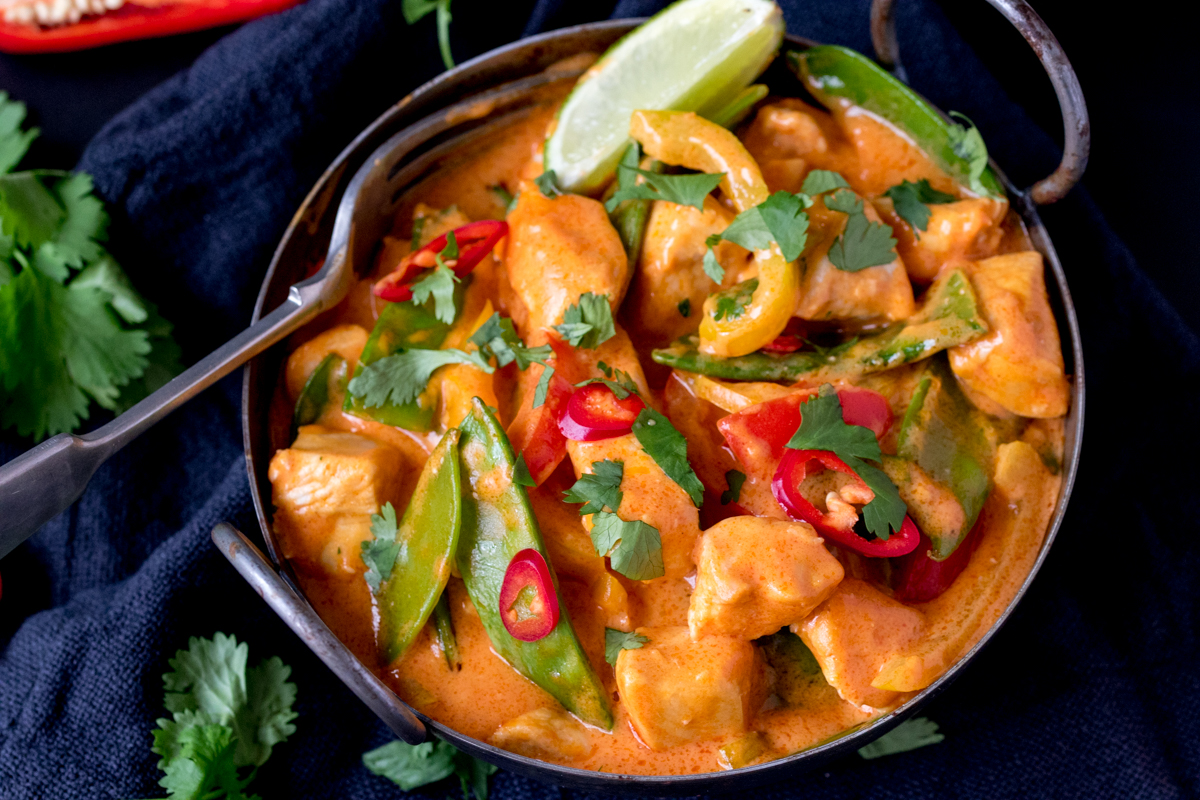
Making a delicious Thai vegetable red curry is a journey of balancing fragrant spices, vibrant vegetables, and creamy coconut milk. This process, while seemingly complex, breaks down into manageable steps, allowing you to create a restaurant-quality dish in your own kitchen. The key is to pay attention to the order of adding ingredients and to control the heat carefully to prevent burning the delicate spices.
We’ll begin by preparing the aromatics and vegetables before building the curry’s rich flavor profile. The cooking time will vary slightly depending on the vegetables used, but the overall process remains consistent. Remember, taste as you go and adjust seasonings to your preference.
Preparing the Ingredients
Before you start cooking, meticulously prepare all your ingredients. This will streamline the cooking process and ensure a smoother experience. Proper preparation is essential for achieving a harmonious balance of flavors and textures.
- Chop 1 large onion into roughly 1-inch pieces. Image 1: Show the chopped onion, its layers neatly separated, ready for sautéing. The onion should be a pale yellow or white, showing no signs of bruising.
- Finely mince 2-3 cloves of garlic and 1-inch piece of ginger. Image 2: Show the finely minced garlic and ginger, emphasizing their fresh, vibrant color. The garlic should be pale white, and the ginger should have a light beige or yellow hue.
- Prepare your vegetables: Cut 1 red bell pepper, 1 green bell pepper, and 1 cup of broccoli florets into bite-sized pieces. You can also add other vegetables like zucchini, eggplant, or bamboo shoots. Image 3: Showcase the assorted vegetables, neatly arranged and uniformly cut. The vegetables should be vibrant and firm, showcasing their freshness.
- Measure out 2 tablespoons of Thai red curry paste. Image 4: Display the vibrant red curry paste in a spoon or small bowl. The paste should have a deep, rich crimson color with visible flecks of chili and other spices.
- Have ready 1 (13.5-ounce) can of full-fat coconut milk, 1 cup of vegetable broth, 1 tablespoon of fish sauce (or soy sauce for a vegetarian version), 1 tablespoon of brown sugar, and the juice of 1 lime.
Building the Curry
This section details the step-by-step process of combining the ingredients to create the rich and flavorful Thai vegetable red curry. Careful attention to timing and temperature is crucial to unlocking the full potential of the spices and achieving a well-balanced dish.
- Heat 2 tablespoons of vegetable oil in a large pot or wok over medium heat. Add the chopped onion and sauté for about 5 minutes, until softened and translucent. Image 5: Show the onions gently sautéing in the hot oil, becoming translucent and slightly softened. The oil should be shimmering but not smoking.
- Add the minced garlic and ginger and sauté for another minute, until fragrant. Image 6: Show the garlic and ginger added to the onions, releasing their aromatic oils. The mixture should be fragrant and slightly golden.
- Add the red curry paste and stir-fry for 1-2 minutes, until fragrant. Image 7: Show the vibrant red curry paste being added to the hot oil, releasing its fragrant aroma. The paste should be a deep, rich crimson, with visible flecks of chili and other spices.
- Add the vegetables and stir-fry for 5-7 minutes, until slightly tender-crisp. Image 8: Show the vegetables added to the curry paste, being stirred and cooked until slightly softened but still retaining some texture.
- Pour in the coconut milk and vegetable broth. Bring to a simmer, then reduce heat to low and cook for 10-15 minutes, or until the vegetables are cooked through. Stir occasionally. Image 9: Show the coconut milk and vegetable broth added to the curry, creating a creamy and flavorful base.
- Stir in the fish sauce (or soy sauce), brown sugar, and lime juice. Taste and adjust seasonings as needed. Image 10: Show the final adjustments being made, highlighting the balance of flavors and colors.
Presentation
The final presentation significantly impacts the dining experience. A visually appealing dish enhances the overall enjoyment. Here are some tips for creating a stunning Thai vegetable red curry.
Serve the curry hot, garnished with fresh cilantro leaves and a squeeze of extra lime juice. Consider serving it with steamed jasmine rice or roti bread for dipping. Image 11: Show the finished curry served in a bowl, garnished with fresh cilantro and a lime wedge. The curry should have a rich, creamy texture and vibrant color. The presentation should be neat and inviting.
Serving Suggestions and Accompaniments
The beauty of Thai veg red curry lies not only in its vibrant flavors but also in its versatility. It’s a dish that thrives on complementary textures and tastes, allowing for a delightful range of accompaniments to elevate the dining experience. Choosing the right additions can transform a simple meal into a truly memorable one.
The rich, slightly sweet and spicy notes of the curry pair exceptionally well with elements that offer contrasting textures and flavors. Think of the creamy coconut milk base – it’s beautifully balanced by the crispness of fresh vegetables or the satisfying chewiness of certain grains. The subtle heat of the chilies is softened by cooling elements, while the aromatic spices are enhanced by fragrant herbs.
Ideal Accompaniments for Thai Veg Red Curry
A selection of accompaniments can significantly enhance the enjoyment of Thai veg red curry. These additions provide textural and flavor contrasts, creating a more complex and satisfying culinary experience.
- Steamed Jasmine Rice: The fluffy grains of jasmine rice absorb the delicious curry sauce beautifully, providing a neutral base that lets the curry’s flavors shine. The soft texture contrasts beautifully with the vegetables in the curry.
- Coconut Rice: For an even richer experience, coconut rice adds another layer of coconut flavor that complements the curry’s creamy base. The subtle sweetness of the coconut enhances the overall taste profile.
- Naan Bread: The soft, slightly chewy texture of naan bread is perfect for scooping up the curry sauce. The bread’s mild flavor doesn’t compete with the curry’s robust spices.
- Fresh Herbs: A scattering of fresh cilantro, basil, or mint adds a refreshing touch and a burst of vibrant green color to the dish. These herbs provide a cooling counterpoint to the spice.
- Lime Wedges: A squeeze of fresh lime juice brightens the flavors of the curry, adding a touch of acidity that cuts through the richness of the coconut milk. It’s a simple but effective way to enhance the overall taste.
A Sample Menu Featuring Thai Veg Red Curry
This menu showcases the versatility of Thai veg red curry by incorporating a range of flavors and textures, creating a well-rounded and satisfying meal.
- Appetizer: Fresh Spring Rolls with Peanut Sauce – The light and refreshing spring rolls offer a palate-cleansing start to the meal, contrasting with the richness of the main course.
- Main Course: Thai Veg Red Curry served with Jasmine Rice and a side of Naan bread.
- Dessert: Mango Sticky Rice – The sweet and creamy mango sticky rice provides a delightful end to the meal, offering a contrast in both texture and flavor from the savory curry.
Presentation of Thai Veg Red Curry
The visual appeal of a dish is just as important as its taste. A well-presented Thai veg red curry is both inviting and appetizing.
To enhance the presentation, consider serving the curry in a shallow bowl to showcase its vibrant color and the variety of vegetables. Garnish with fresh herbs like cilantro or basil, scattered artfully across the surface. A sprinkle of toasted sesame seeds adds texture and visual interest. A small wedge of lime placed on the side adds a pop of color and offers a final touch of acidity for the diner. Consider using a contrasting color for the serving bowl or plate to make the curry colors stand out even more. For example, a dark-colored bowl will make the vibrant red of the curry appear even more intense.
Nutritional Information and Health Benefits: Thai Veg Red Curry Recipe
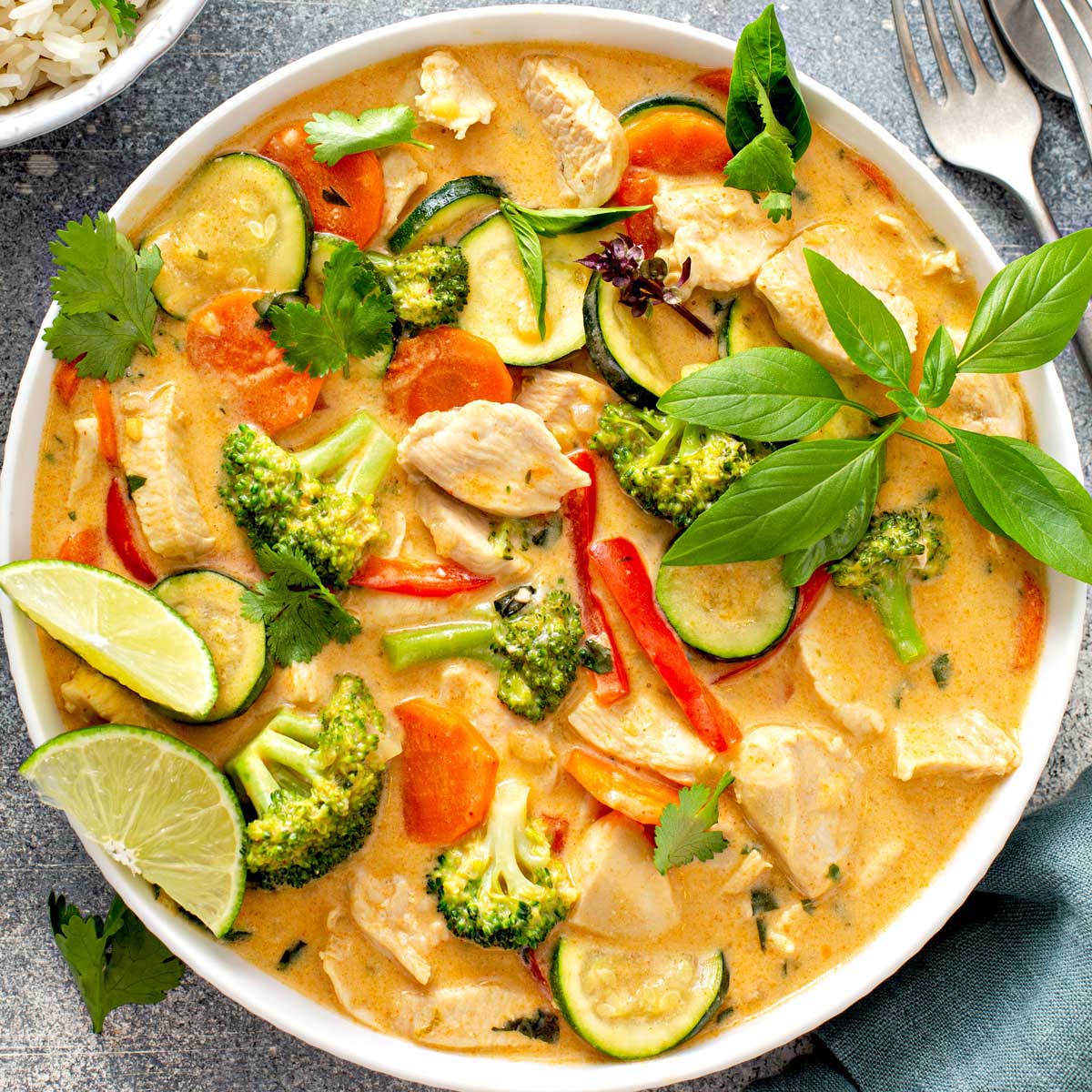
Thai vegetable red curry offers a delicious and surprisingly healthy meal option. While the exact nutritional content varies depending on the specific ingredients and portion size, a typical serving provides a good balance of vitamins, minerals, and fiber, while remaining relatively low in fat and calories compared to some other curry dishes. Understanding the nutritional profile and health benefits of the key components allows us to appreciate this dish’s place in a balanced diet.
Nutritional Breakdown of a Typical Serving
A single serving (approximately one and a half cups) of a Thai vegetable red curry, prepared with coconut milk, vegetables like bell peppers, bamboo shoots, and eggplant, and a moderate amount of red curry paste, might contain approximately 300-400 calories. This calorie range can fluctuate depending on the amount of coconut milk used. The macronutrient breakdown would likely include roughly 15-20 grams of protein, 20-30 grams of fat (largely unsaturated fats from coconut milk and vegetable oils), and 25-35 grams of carbohydrates, primarily from vegetables and coconut milk. The dish is also a good source of dietary fiber, contributing to digestive health. Vitamins and minerals present will vary depending on the vegetables included, but typically include vitamin A, vitamin C, potassium, and various other micronutrients. Precise figures require laboratory analysis of a specific recipe.
Health Benefits of Key Ingredients
Many ingredients in Thai vegetable red curry contribute significantly to its health benefits. Coconut milk, while high in saturated fat, also contains medium-chain triglycerides (MCTs), which are metabolized differently than other fats and may offer some energy benefits. The abundance of vegetables provides a wealth of vitamins, minerals, and antioxidants. For instance, bell peppers are rich in vitamin C, a powerful antioxidant; eggplant is a good source of fiber and antioxidants; and bamboo shoots offer fiber and various minerals. Ginger and garlic, common in red curry paste, possess anti-inflammatory properties. Chili peppers, another key component of the paste, can boost metabolism and have potential pain-relieving effects. However, it’s crucial to note that these benefits are dependent on the quality and quantity of ingredients used.
Comparison to Other Curry Recipes
Compared to richer, creamier curries that rely heavily on coconut milk and dairy products, Thai vegetable red curry is generally lower in fat and calories. Meat-based curries will naturally have a higher protein content, but the vegetable version offers a significant advantage in terms of fiber and vitamins. The absence of meat also makes it a suitable option for vegetarians and vegans. However, the nutritional profile can vary greatly depending on the specific recipe and the type of vegetables used. For example, a curry made with potatoes will have a higher carbohydrate content than one with mainly leafy greens.
Potential Dietary Benefits and Drawbacks
The dietary benefits of Thai vegetable red curry include its high fiber content, promoting digestive health; the presence of antioxidants, which combat free radical damage; and a good source of vitamins and minerals essential for overall health. However, the relatively high sodium content, often stemming from soy sauce or fish sauce in the red curry paste, can be a drawback for individuals watching their sodium intake. The coconut milk content, while offering some benefits, contributes to the fat content of the dish, which should be considered by those managing their cholesterol levels. Those with specific dietary restrictions or allergies should carefully check the ingredients used in the recipe.
